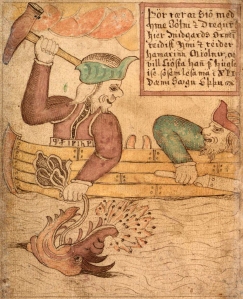The Drowned God is an very unique one– a harsh deity and his religion is a harsh one, favoring reaving and plundering in its name. Children are initiated into the faith by being drowned in sea water and resuscitated. The Greyjoy family is the principal family of the Iron Islands, with the sigil of a Kraken, bears the words “We do not Sow” to indicate that Ironborn do not grow food, but take it for themselves.
While to outsiders the Drowned God religion seems like a thinly veiled justification for pillaging and plundering, the ironborn themselves take their religion very seriously, and actually have a fairly well developed cosmology and belief system surrounding it. Within this belief system, the Drowned God is locked in an age-old struggle against the Storm God. The Drowned God’s halls are located beneath the ocean, while the Storm God lives in a castle in the sky with his thunderclouds. The Storm God is constantly trying to send storms to dash ironborn ships against rocks to their ruin.
The lifestyle of the Ironborn that worship the Drowned God is very much akin to that of the Vikings– raping, pillaging towns along the coast. By this comparison, it should be no surprise that the Drowned God takes very much after Norse Mythology. With the kraken as the Greyjoy sigil, GRRM even seems to invite the atmosphere of sea monsters and mythos as an elemental part of the Drowned God’s religion.
Norse mythology consists of tales of various deities, beings, and heroes derived from numerous sources from both before and after the pagan period, including medieval manuscripts, archaeological representations, and folk tradition. Most prevalent to the Ironborns’ traditions is the powerful god Njörðr, who may calm both sea and fire and grant wealth and land.
In Norse Mythology, Njörðr is a seafaring god among the Vanir, and is associated with sea, seafaring, wind, fishing, and wealth. Prose Edda tells of the ill-fated marriage of Njörðrwith the goddess Skaði, the goddess associated with bowhunting, winter, and mountains. This story bears striking resemblance to the fabled war between the Storm God and The Drowned God, another religious duality of two entities that may only coexist in opposition to one another, much like that of Red Faith’s R’hollor and the Great Other.
Another congruity between GRRM’s universe and is the comparison between the Sea Dragon Nagga of the Iron Islands and the Norse Sea Serpent Jörmungandr. According to the Prose Edda, Odin took Loki’s three children by Angrboða, the wolf Fenrir, Hel and Jörmungandr, and tossed Jörmungandr into the great ocean that encircles Midgard.
The serpent grew so large that he was able to surround the earth and grasp his own tail. As a result, he received the name of the Midgard Serpent or World Serpent. It is said that when Jörmungandr lets go, the world will end.
The last meeting between the serpent and Thor is predicted to occur at Ragnarök, when Jörmungandr will come out of the ocean and poison the sky. According to legend, Thor is to kill Jörmungandr and then walk nine paces before falling dead, having been poisoned by the serpent’s venom.

An illustration of the god Thor and the jötunn Hymir on the sea, where Thor gets Jörmungandr on the hook; from an Icelandic 18th century manuscript.
The story of Nagga tells a story of different consequences with similar undertones. According to the ironborn legend, Nagga was the first sea dragon, able to feed on krakens and leviathans and drown islands when angry.
During the Age of Heroes, the Grey King, helped by the Drowned God, managed to slay her on the shores of the island Old Wyk and built there his hallout of her bones. Her jaws became his throne and her teeth made his crown. He warmed his hall with her living fire. However, when the Grey King died, the Storm God drowned out her fire and the sea took the throne.
The connection of the Sea dragon/serpent alongside the Norse tradition of reaping and pillaging bears the strongest argument for a correlation between the Drowned God and Norse Mythology. However, another bizarre connection to H.P. Lovecraft’s Cult of Cthulhu builds an interesting case for itself.
One of the most commonly repeatedly phrase amongst the “Drowned Men” (priests of the Drowned God) “What is Dead may never Die.”
During the blessing ceremony, the following exchange occurs as the priest pours holy sea water over the adherent’s head:

- Drowned Priest: “Let [name] your servant be born again from the sea, as you were. Bless him with salt, bless him with stone, bless him with steel.”
- Response: “What is dead may never die.”
- Drowned Priest: “What is dead may never die, but rises again, harder and stronger.”
Contrast that with the classic Lovecraftian couplet:
“That is not dead which can eternal lie,
And with strange aeons even death may die.”
Interesting coincident, though I have no doubt that GRRM was a solid Lovecraft fan. And it seems reasonable that a group of followers who identify with the sigil of a kraken would follow such a model.








